机械原理英语版
机械原理英文版答案
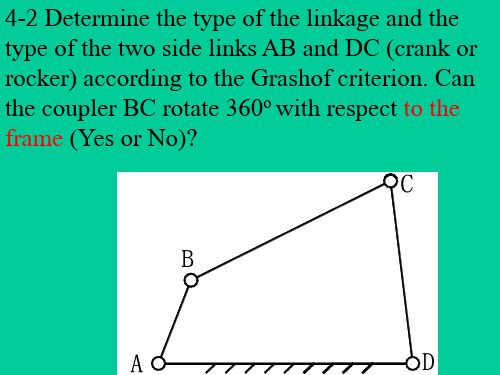
C 1
b a
B 2
C 2
θ
Ψ
m a x D
c
ω
1
A
d
B 1
(e) will any dead-point occur during the whole cycle of the motion? No. (d) find the maximum pressure angle αmax and the minimum transmission angle γmin. γmin =min{γmin′, γmin′′} 不能只求γmin′ !!!
C2 C1 B2 A B1 max
=0°
D
C 1
b a
B 2
C 2 m a x D
Ψ
c
A B 1 F
d
ω
α
V
若DC为原动件,图示两位置的γ不是γmin!!
γ
γ
4-5 In the offset slider-crank mechanism shown in Fig.4-5, the driver crank AB rotates at a constant speed. Let LAB=120mm, LBC=250mm, offset e=60mm, and ϕAB=60o. Find
机械原理英文Mechanical principles
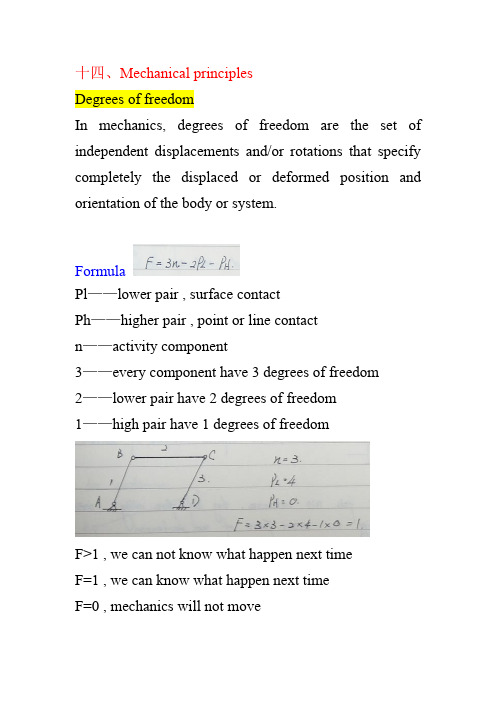
十四、Mechanical principlesDegrees of freedomIn mechanics, degrees of freedom are the set of independent displacements and/or rotations that specify completely the displaced or deformed position and orientation of the body or system.FormulaPl——lower pair , surface contactPh——higher pair , point or line contactn——activity component3——every component have 3 degrees of freedom 2——lower pair have 2 degrees of freedom1——high pair have 1 degrees of freedomF>1 , we can not know what happen next timeF=1 , we can know what happen next timeF=0 , mechanics will not move三审,笔试,有三个图,分别计算哪个结构是稳定的,第一个是稳定的,第二个是稳定但是有过度约束,第三个不稳定可运动。
在过度约束中,审核官问我知道不知道一个公式s=2k-3,我不明白,回来和同学讨论觉得这个应该是计算虚约束的公式,请多注意。
Plane mechanism`s motion analysisInstantaneous center of velocityRevolute pair join, two mechanism , instantaneous center of velocity in center of revolute pair.Rod 1 and rod 2 are combined by revolute pair, P12 is instantaneous center of velocity.Pure-slide pair join, two mechanism , instantaneous center of velocity infinite distance of vertical motion direction.A move along rod B. P12 in infinite distance of vertical rodB .High pair join , two mechanism , they are pure rolling , instantaneous center of velocity in contact point of two mechanism.P12 is instantaneous center of velocityHigher pair join , two mechanism , they are relative slide , instantaneous center of velocity in base tangent.P12 in t-t.Kennedy-Aronhold theoremP13 in P12 and P23 join line. P13 in P14 and P34 join line. P24 in P12 and P14 join line. P24 in P23 and P34 join line.2 and 4 velocity is same in P24Plane four bar mechanismA and D fix called stander , AB CD called side link. Link can rotation called crank--ABLink can shake in range of degree called rocker--CD Crank-rocker mechanismRadarDouble-crank mechanismTrain wheelDouble-rocker mechanismCraneCam mechanismAdvantag e: structure is simple, respond is quickly. Disadvantage: cam produce is difficult, easily wear between cam and follower.GearA gear is a component within a transmission device that transmits rotational force to another gear or device. Spur gearSpur gear are used for low speed applications and those situations where noise control is not a problem.Helical gearHelical gear operate more smoothly than do spur gear. The use of helical gears is indicated when the application involves high speeds , large power transmission or where noise abatement is important,A disadvantage of helical gear is a resultant thrust along the axis of the gear , which needs to be accommodated by appropriate thrust bearing , and a greater degree of sliding friction between the meshing teeth , often addressed with specific additives in the lubricant. Double helical gearsDouble helical gears , also know as herringbone gears , overcome the problem of axis thrust presented by single helical gears by having teeth that set in a "V" shape. Bevel gearThe angle between the shafts can be anything except 0 and 180 degree.Worm gearThe prime feature of a worm-and-gear set is that it allows the attainment of a high gear ratio with few parts in a small space.Rack and pinionTorque cam be converted to linear force by meshing a rack with a pinion : the pinion turns the rack moves in a straight line.Planet gear。
机械原理英语

机械原理英语Mechanical Principles in English。
Mechanical principles are the foundation of engineering and technology. Understanding these principles is crucial for anyone working in the field of mechanical engineering. In this document, we will discuss some of the key mechanical principles in English.First and foremost, it is important to understand the concept of force. Force is a vector quantity that can cause an object to accelerate, decelerate, or change direction. It is measured in units of newtons and is represented by the symbol F. The magnitude and direction of a force are essential in determining its effect on an object.Next, let's consider the concept of work and energy. Work is done when a force acts on an object to move it a certain distance. The amount of work done is equal to the force applied multiplied by the distance moved in the direction of the force. Energy, on the other hand, is the ability to do work. There are different forms of energy, including kinetic energy (energy of motion) and potential energy (energy of position).Another important mechanical principle is the study of simple machines. Simple machines are basic mechanical devices that apply a force to accomplish work. The six types of simple machines are the lever, wheel and axle, pulley, inclined plane, wedge, and screw. These simple machines can be combined to create more complex machines that make work easier.Furthermore, it is crucial to understand the concept of mechanical advantage. Mechanical advantage is a measure of the force amplification achieved by using a tool, mechanical device, or machine system. It is calculated by dividing the output force by the input force. Understanding mechanical advantage is essential for designing and optimizing mechanical systems.Additionally, the study of motion and its principles is fundamental in mechanical engineering. Motion is described in terms of displacement, velocity, and acceleration.The laws of motion, formulated by Sir Isaac Newton, are the foundation of classical mechanics. These laws describe the relationship between the motion of an object and the forces acting on it.Moreover, the study of fluid mechanics is essential in understanding the behavior of fluids (liquids and gases) and their interactions with solid objects. Fluid mechanics plays a crucial role in various engineering applications, including the design of pumps, turbines, and hydraulic systems.In conclusion, the study of mechanical principles in English is essential for anyone working in the field of mechanical engineering. Understanding concepts such as force, work and energy, simple machines, mechanical advantage, motion, and fluid mechanicsis crucial for designing and optimizing mechanical systems. By mastering these principles, engineers can develop innovative solutions to complex engineering problems and contribute to the advancement of technology and society.。
机械原理英语版
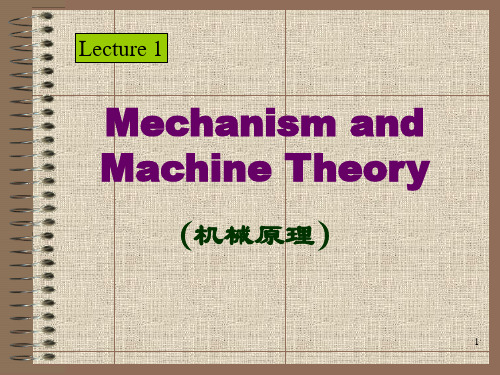
Characteristics:
(1) It is a composition of links.
(人为构件的组合体)
(2) There is a determined relative motion between links.
(各构件之间有确定的相对运动)
(3) It can transform or transmit energy.
15
References
8 . Erdman A. G., Sandor G. N., Mechanism Design: Analysis and Synthesis, Prentice-Hall International Inc, 1984 9*. Eckhand H. D., Kinematic Design of Machines and Mechanisms , McGraw-Hill, 1998 10*. Shigley J. E. and Uicker J.J. Theory of Machines and Mechanisms, McGraw-Hill, 2nd edition, 1995 11*. Norton R. L., Design of Machinery – An Introduction to the Synthesis and Analysis of Mechanisms and Machines, McGraw-Hill, 2nd edition, 2001 * 影印版,机械工业出版社,2002
(国际机构与机器理论联合会)
2. Kinematics and Dynamics
(High speed, precision, efficiency, etc.)
(高速,高精度,高效率等)
机械原理中英文对照
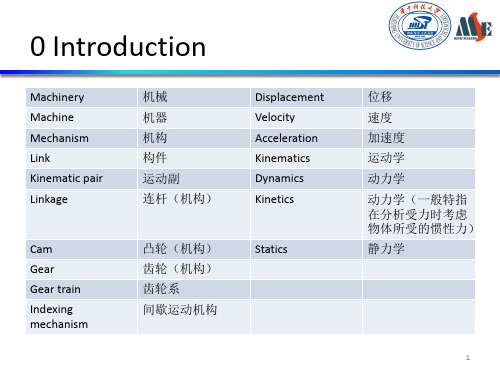
径向槽 运动循环 运动系数 顶锥角 根锥角 顶隙
Intermittenk?url=TfmxJn 5IdPnJvmDfGji 11 kv9eVc8nK1YG
Cam Gear Gear train
凸轮(机构) 齿轮(机构) 齿轮系
Statics
Indexing mechanism
间歇运动机构
1
1 Composition and Mobility of Planar Mechanisms
Planar mechanism Mobility
Links Kinematic pairs Joints Elements Revolute Hinge Slider Cam pair Compound hinge Local DOF
0 Introduction
Machinery Machine Mechanism Link Kinematic pair Linkage 机械 机器 机构 构件 运动副 连杆(机构) Displacement Velocity Acceleration Kinematics Dynamics Kinetics 位移 速度 加速度 运动学 动力学 动力学(一般特指 在分析受力时考虑 物体所受的惯性力) 静力学
螺旋线 渐开螺旋面 端面 法面
Superscript Subscript Lead Ellipse
上标 下标 导程 椭圆
9
5 Gear Trains
Spur gears Helical gears Pinion Rack Bevel gears Worm Worm wheel External gears Internal gears Gear train with fixed axes Epicyclic gear train 直齿轮 斜齿轮 小齿轮 齿条 圆锥齿轮 蜗杆 蜗轮 外啮合齿轮 内啮合齿轮 定轴轮系 周转轮系 Planetary gear train Differential gear train Combined gear train Train ratio Sun gear Planet gear Planet carrier Peripheral velocity 行星轮系 差动轮系 复合轮系 (轮系的)传动比 太阳轮,中心轮 行星轮 转臂 圆周速度
机械原理英语版范文
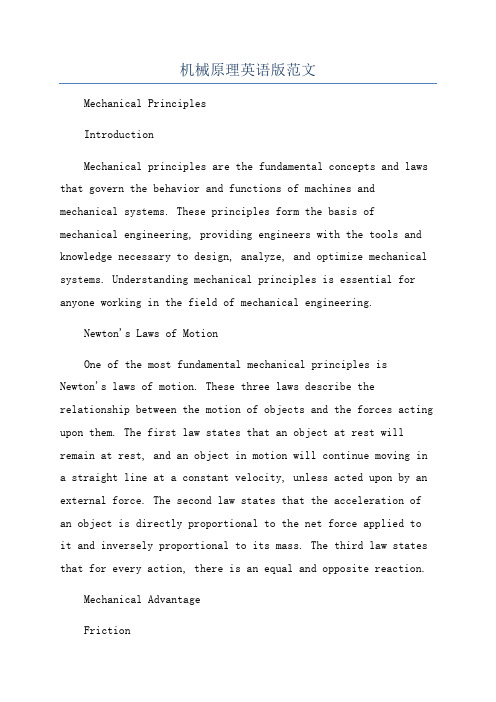
机械原理英语版范文Mechanical PrinciplesIntroductionMechanical principles are the fundamental concepts and laws that govern the behavior and functions of machines and mechanical systems. These principles form the basis of mechanical engineering, providing engineers with the tools and knowledge necessary to design, analyze, and optimize mechanical systems. Understanding mechanical principles is essential for anyone working in the field of mechanical engineering.Newton's Laws of MotionOne of the most fundamental mechanical principles isNewton's laws of motion. These three laws describe the relationship between the motion of objects and the forces acting upon them. The first law states that an object at rest will remain at rest, and an object in motion will continue moving in a straight line at a constant velocity, unless acted upon by an external force. The second law states that the acceleration of an object is directly proportional to the net force applied to it and inversely proportional to its mass. The third law states that for every action, there is an equal and opposite reaction.Mechanical AdvantageFrictionFriction is another important mechanical principle. It is the force that opposes the relative motion of two surfaces in contact with each other. Friction can be both beneficial and detrimental. On one hand, it allows us to walk, drive vehicles, and hold objects without slipping. On the other hand, it causes a loss of energy and wear and tear in mechanical systems. Engineers must take friction into account when designing machines to ensure they function efficiently and reliably.TorqueStress and StrainConclusionThese are just a few of the many mechanical principles that form the foundation of mechanical engineering. By understanding these principles, engineers can design efficient and reliable machines that meet the needs of society. Mechanical engineering continues to advance, with new technologies and principles being discovered and applied every day. The principles discussed here provide a solid starting point for aspiring mechanical engineers to build upon as they delve deeper into the field.。
机械原理英语作文模板
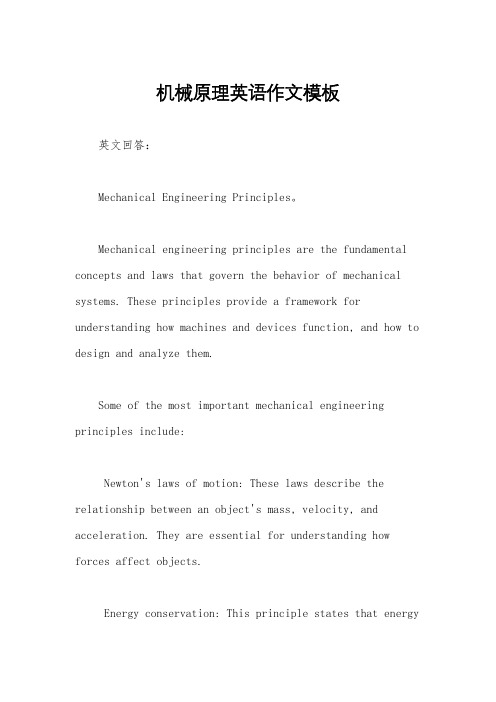
机械原理英语作文模板英文回答:Mechanical Engineering Principles。
Mechanical engineering principles are the fundamental concepts and laws that govern the behavior of mechanical systems. These principles provide a framework for understanding how machines and devices function, and how to design and analyze them.Some of the most important mechanical engineering principles include:Newton's laws of motion: These laws describe the relationship between an object's mass, velocity, and acceleration. They are essential for understanding how forces affect objects.Energy conservation: This principle states that energycannot be created or destroyed, only transferred or transformed. It is a fundamental principle of physics that applies to all mechanical systems.Momentum conservation: This principle states that the total momentum of a system remains constant, as long as there are no external forces acting on it. It is a fundamental principle of physics that applies to all mechanical systems.Angular momentum conservation: This principle states that the total angular momentum of a system remains constant, as long as there are no external torques acting on it. It is a fundamental principle of physics that applies to all mechanical systems.Elasticity: This property describes the ability of a material to deform under stress and then return to its original shape when the stress is removed. It is an important property for many mechanical systems, such as springs and shock absorbers.Plasticity: This property describes the ability of a material to deform permanently under stress. It is an important property for many mechanical systems, such as metals and polymers.Strength: This property describes the ability of a material to resist deformation or fracture under stress. It is an important property for many mechanical systems, such as beams and columns.Stiffness: This property describes the resistance of a material to deformation under load. It is an important property for many mechanical systems, such as springs and shafts.These are just a few of the many mechanical engineering principles that are used to design and analyze mechanical systems. By understanding these principles, engineers can create machines and devices that are safe, efficient, and reliable.中文回答:机械原理。
机械原理第一章cup英文版

Course information and requirements
Information
Shimin Zhang(张仕民) Office: Rm. 602, New Bldg. Tel.: 89733835(o) E-mail: smzhang@
Course information and requirements
How to analyze mechanism & How to synthesize mechanism?
What are we going to study in this course?
The Content of our course
It is broadly divided into two parts. 1. Kinematics of Mechanism: the study of motion
mechanisms & How to synthesize mechanisms
What are we going to study in this course?
Example of the Machines and Mechanisms
Mechanisms: pencil sharper, clock, folding chair, adjustable desk lamp, bike Machines: robots, bulldozer, park rides, elevator, engine. Can you give more examples? Some Mechanisms widely used in our life.
How to become an engineer
机械原理英语版培训课件

Oscillating Motion
Explore the concept of oscillating motion and its applications in pendulums and vibrating systems.
Cams and Follower Systems
1
Design Principles
Chain Drives
Understand the design and maintenance of chain drives in industrial machinery.
Actuators and Controls
1 Types of Actuators 2 Control Systems
Kinematics
Understand the principles of motion and the analysis of mechanisms using kinematic equations.
Cams and Follower Systems
Discover the different types of cam mechanisms and their applications in industry.
Explore different types of actuators, including hydraulic, pneumatic, and electric actuators.
Understand the principles of control systems and their role in automating mechanical processes.
Types of Motion and Applications
机械原理(双语)第一章

Piston 2
Coupler 3 Crank 4 Frame 1
Pinion 4'
Gear 5
Cam 5'
Follower 6 Frame 1
Frame 1 Cam 5" Follower 7 Frame 1
Mechanism(机构) is a system of links(构件) which can transform(转换) or transmit(传递) force and motion.
Piston 2
Coupler 3 Crank 4 Frame 1
Slider-crank mechanism
曲柄滑块机构
1
2
3 4
Piston 2
Coupler 3 Crank 4 Fram
Frame 1
Gear mechanism
齿轮机构
5 1 4'
Piston 2
齿轮机构
Cam mechanism
凸轮机构
1 6
5
3 4
1
4'
5'
Mechanism(机构) is a basic system of links(构件) which can transform(转换) or transmit(传递) force and motion. The function of the slider-crank mechanism is to transform the reciprocation(往复移动) of the piston 2 into the rotation of the crank 4. The function of the gear mechanism is to change the direction and speed of rotation. The function of the cam mechanism is to transform the continuous rotation of the cam into a regular reciprocation of the follower.
机械原理英文经典书籍
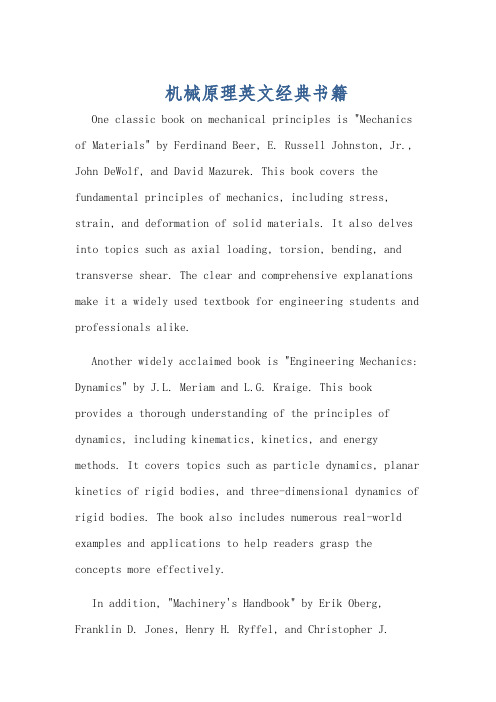
机械原理英文经典书籍One classic book on mechanical principles is "Mechanics of Materials" by Ferdinand Beer, E. Russell Johnston, Jr., John DeWolf, and David Mazurek. This book covers the fundamental principles of mechanics, including stress, strain, and deformation of solid materials. It also delves into topics such as axial loading, torsion, bending, and transverse shear. The clear and comprehensive explanations make it a widely used textbook for engineering students and professionals alike.Another widely acclaimed book is "Engineering Mechanics: Dynamics" by J.L. Meriam and L.G. Kraige. This book provides a thorough understanding of the principles of dynamics, including kinematics, kinetics, and energy methods. It covers topics such as particle dynamics, planar kinetics of rigid bodies, and three-dimensional dynamics of rigid bodies. The book also includes numerous real-world examples and applications to help readers grasp the concepts more effectively.In addition, "Machinery's Handbook" by Erik Oberg, Franklin D. Jones, Henry H. Ryffel, and Christopher J.McCauley is a classic reference for mechanical design and engineering. This handbook contains a wealth of information on mechanical principles, formulas, tables, and standards. It covers a wide range of topics, including mathematics, mechanics and strength of materials, properties and treatment of materials, and much more. It is an indispensable tool for mechanical engineers and machinists.Other notable books on mechanical principles include "Theory of Machines and Mechanisms" by John J. Uicker, Gordon R. Pennock, and Joseph E. Shigley, and "Fundamentals of Machine Component Design" by Robert C. Juvinall and Kurt M. Marshek. These books provide in-depth coverage of the principles and applications of machine design, including mechanisms, mechanical systems, and machine components.以上是一些经典的机械原理书籍,它们涵盖了力学、机械设计和材料力学等领域的基本原理和实际应用。
机械原理英文版7dynamic
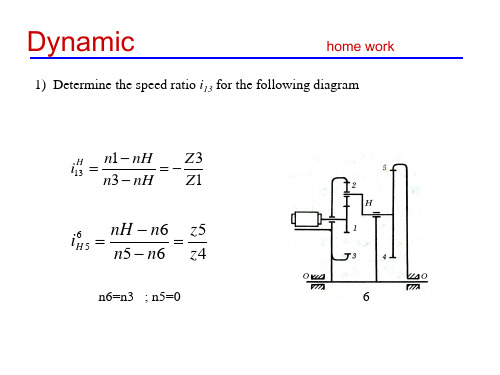
Dynamic
Example in rolling steel material
Dynamic
work piece worktable
Gear rack
Given J1 J2 J2’ and J3 for gears, mass of worktable is M, pitch diameter of z3 is r3, determine the equivalent inertial Je at gear z1
Flywheels
Dynamic
Dynamic
盈功
gained work
a) In the gained case, the speed of system increases
max min
亏功
Loss work
b) In the case of loss work, the speed decreases
Flywheel inertial
90 Emax Is n2k
rpm
Dynamic
Dynamic
Automatic coupler 万向联轴节 a)There is angle between input shaft and output shaft b)If input velocity is uniform, output velocity will be uneven
3 cos i31 1 1 sin 2 cos 1
single universal joint
Dynamic
flutter
Dynamic
double universal coupler
Dynamic
ωc ω1 ω3
机械原理 英文
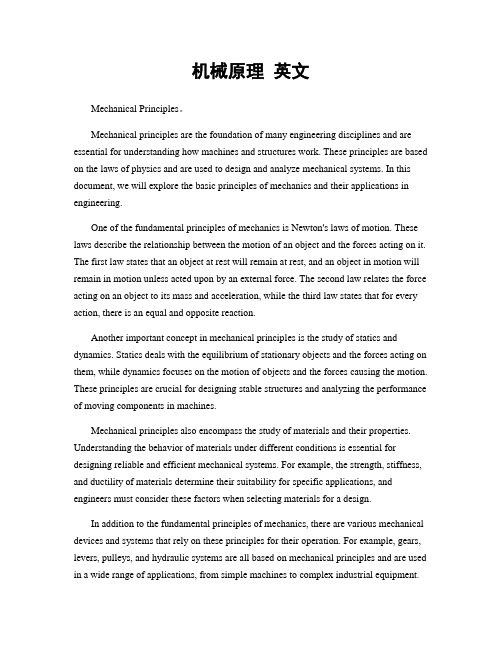
机械原理英文Mechanical Principles。
Mechanical principles are the foundation of many engineering disciplines and are essential for understanding how machines and structures work. These principles are based on the laws of physics and are used to design and analyze mechanical systems. In this document, we will explore the basic principles of mechanics and their applications in engineering.One of the fundamental principles of mechanics is Newton's laws of motion. These laws describe the relationship between the motion of an object and the forces acting on it. The first law states that an object at rest will remain at rest, and an object in motion will remain in motion unless acted upon by an external force. The second law relates the force acting on an object to its mass and acceleration, while the third law states that for every action, there is an equal and opposite reaction.Another important concept in mechanical principles is the study of statics and dynamics. Statics deals with the equilibrium of stationary objects and the forces acting on them, while dynamics focuses on the motion of objects and the forces causing the motion. These principles are crucial for designing stable structures and analyzing the performance of moving components in machines.Mechanical principles also encompass the study of materials and their properties. Understanding the behavior of materials under different conditions is essential for designing reliable and efficient mechanical systems. For example, the strength, stiffness, and ductility of materials determine their suitability for specific applications, and engineers must consider these factors when selecting materials for a design.In addition to the fundamental principles of mechanics, there are various mechanical devices and systems that rely on these principles for their operation. For example, gears, levers, pulleys, and hydraulic systems are all based on mechanical principles and are used in a wide range of applications, from simple machines to complex industrial equipment.The application of mechanical principles is not limited to traditional mechanical engineering disciplines. It also plays a crucial role in fields such as aerospace engineering, automotive engineering, civil engineering, and biomechanics. In aerospace engineering, for instance, the principles of mechanics are used to design aircraft and spacecraft that can withstand the forces of flight and space travel. In automotive engineering, these principles are employed to optimize the performance and safety of vehicles. In civil engineering, they are used to design structures that can withstand various loads and environmental conditions. In biomechanics, mechanical principles are applied to understand the mechanics of the human body and develop medical devices and treatments.In conclusion, mechanical principles are essential for understanding the behavior of machines and structures and are the basis for many engineering disciplines. By studying these principles and their applications, engineers can design innovative and efficient mechanical systems that meet the needs of modern society. Whether it's designing a new machine, developing a new material, or improving an existing system, a solid understanding of mechanical principles is crucial for success in the field of engineering.。
机械原理中英文对照ppt课件

1 Composition and Mobility of Planar Mechanisms
Planar mechanism Mobility Links Kinematic pairs Joints Elements Revolute Hinge Slider Cam pair Compound hinge Local DOF
摩擦 磨损 载荷 行程 推程 回程 休止 远休止 近休止 位移 速度 加速度
4
3 Continued
Jerk Base circle Angular velocity Oscillating angle Center distance Constant Polynomial Rigid impulse Soft impulse Pressure angle
反演 急回机构 摆角 压力角 传动角 死点 行程 回程 中点 垂线 平行四边形 机构 摇杆极位
3
3 Analysis and Synthesis of Cam Mechanisms
Cam Follower Translate Oscillate Roller Knife-edge follower Flat-faced follower In-line Offset Profile Contact stress现方式做保护处理对用户上传分享的文档内容本身不做任何修改或编辑并不能对任何下载内容负责
0 Introduction
Machinery Machine Mechanism Link Kinematic pair Linkage
机械 机器 机构 构件 运动副 连杆(机构)
Geneva
日内瓦(瑞士) Motion cycle
Ratchet mechanism 棘轮机构
机械原理英文课件:Chap8 design of gear mechanism
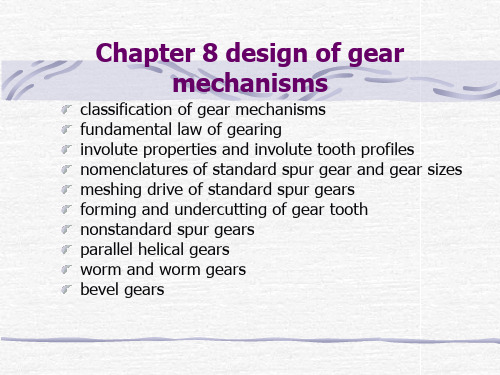
(1)intersecting shaft gears
the curved teeth bevel gear has teeth that are curved with a zero degree spiral angle they are quieter in action than the other bevel gears
• Motion is to be transmitted between shafts whose axes intersect or skew by gears
1. Parallel shaft gears
called planar gear mechanism
Spur gears Helical gears Herringbone gears
齿轮用于传递(变换)运动和力。 (1)speed transformation转速大小的变换
w1
(avi) w2
齿数比 z1 决定转速变换量 z2
z1
w2 =
z1 z2
w1
z2
(2) Changing speed direction转速方向的变换
(avi)
(avi)
(avi)
rotation direction of parallel axis external contact gear transmission can be changed
(avi)
(avi)
(avi)
相交轴外啮合齿轮传动不仅改变齿轮的回转方向还改
变运动
改变齿轮的回转
方向还改变运动
的传递方向
机械原理英文课件:introduction
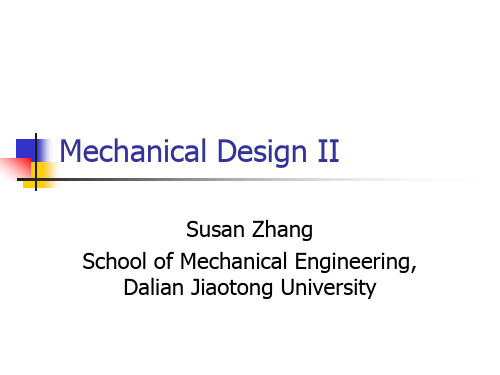
Contents of Mechical Principle
Structural analysis of planar mechanisms(平面机构 的结构分析)
The shuttle casts Harbert Space Telescope using mechanical arm
Spider mine detection robot
Micro mechanical components of micron(微米) size are made by lithography technology(光刻技术)
Engineering drawing(工程制图) Interchangeability and measurement
basis(互换性与测量技术基础) Mechanical principal(机械原理) Mechanical component(机械零件)
Engineering drawing
Organization of the Course
1. Class Instruction 2. Homework & Presentation 3. A Lot of Experiments 4. Simple Projects & Research Reports 5. Discussion & Communication 6. No Examination or quiz
Tolerance
Mechanical principal
Mechanism of pestle rice捣米机构 Zhang Heng’s seismograph张衡地动仪 Du Shi’s Water drainage杜诗水排
机械原理外语版linkage
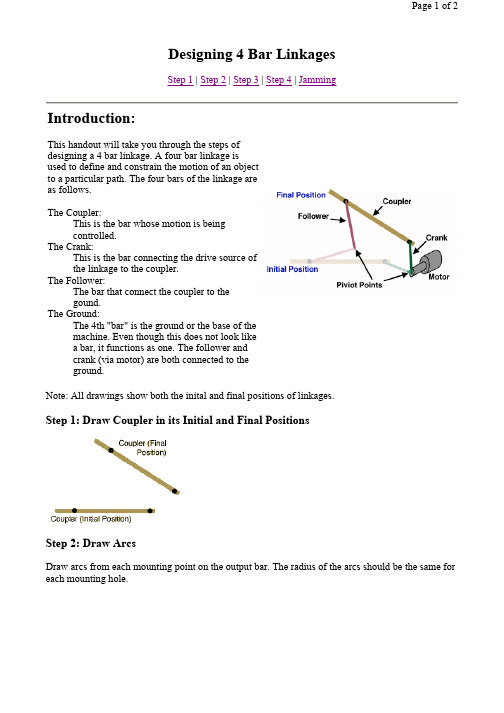
Designing 4 Bar LinkagesStep 1 | Step 2 | Step 3 | Step 4 | JammingIntroduction:This handout will take you through the steps ofdesigning a 4 bar linkage. A four bar linkage isused to define and constrain the motion of an objectto a particular path. The four bars of the linkage areas follows.The Coupler:This is the bar whose motion is beingcontrolled.The Crank:This is the bar connecting the drive source ofthe linkage to the coupler.The Follower:The bar that connect the coupler to thegound.The Ground:The 4th "bar" is the ground or the base of themachine. Even though this does not look likea bar, it functions as one. The follower andcrank (via motor) are both connected to theground.Note: All drawings show both the inital and final positions of linkages.Step 1: Draw Coupler in its Initial and Final PositionsStep 2: Draw ArcsDraw arcs from each mounting point on the output bar. The radius of the arcs should be the same for each mounting hole.Step 3: Draw Locus LinesDraw a pair of lines, one connecting the intersections of each pair of arcs. These lines represent the locus of possible end points for the connecting links.Step 4: Draw Connecting BarsDraw in the connecting bars. There are many possible location for the mounting point on connecting bars. The two figures below show equally valid possibilities for the location of the connecting bars in this example. The initial and final positions of all bars are shown.orTo prevent the linkage from jamming, the mounting point for the connecting bars should not be placed in line with the output bar's mounting hole's initial and final positions. See figure below.。
机械原理英文
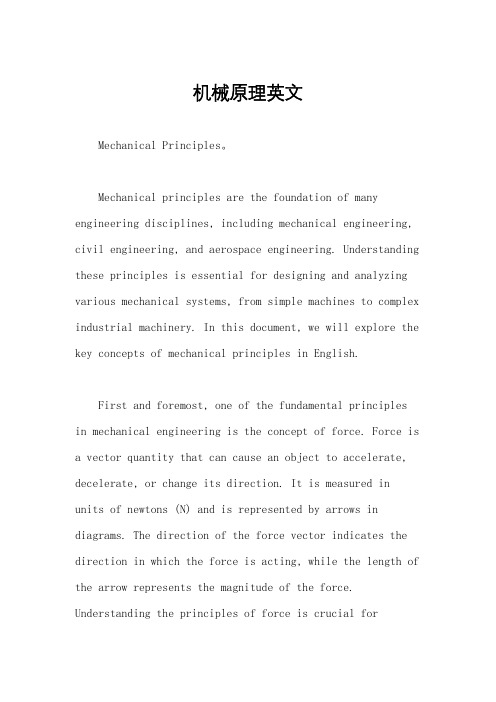
机械原理英文Mechanical Principles。
Mechanical principles are the foundation of many engineering disciplines, including mechanical engineering, civil engineering, and aerospace engineering. Understanding these principles is essential for designing and analyzing various mechanical systems, from simple machines to complex industrial machinery. In this document, we will explore the key concepts of mechanical principles in English.First and foremost, one of the fundamental principlesin mechanical engineering is the concept of force. Force is a vector quantity that can cause an object to accelerate, decelerate, or change its direction. It is measured inunits of newtons (N) and is represented by arrows in diagrams. The direction of the force vector indicates the direction in which the force is acting, while the length of the arrow represents the magnitude of the force. Understanding the principles of force is crucial foranalyzing the behavior of mechanical systems under various loading conditions.Another important concept in mechanical principles is the study of motion. Motion is the change in position of an object over time and is described using parameters such as displacement, velocity, and acceleration. The laws of motion, as formulated by Sir Isaac Newton, provide the foundation for understanding the behavior of objects in motion. These laws, including the famous second law F=ma, are essential for analyzing the dynamics of mechanical systems and predicting their behavior under different operating conditions.In addition to force and motion, mechanical principles also encompass the study of energy and power. Energy is the ability to do work, and it exists in various forms such as kinetic energy, potential energy, and thermal energy. Understanding the principles of energy is essential for designing efficient mechanical systems and optimizing their performance. Power, on the other hand, is the rate at which work is done or energy is transferred, and it is a keyparameter in the design and operation of mechanical devices.Furthermore, the principles of mechanics also includethe study of materials and their mechanical properties. Materials play a crucial role in the design andconstruction of mechanical systems, and their behaviorunder different loading conditions is essential forensuring the safety and reliability of engineering structures. Understanding concepts such as stress, strain, and elasticity is essential for designing materials thatcan withstand the forces and loads they are subjected to in real-world applications.Moreover, mechanical principles also encompass thestudy of fluid mechanics, which deals with the behavior of fluids (liquids and gases) and the forces acting on them. Understanding the principles of fluid mechanics isessential for designing hydraulic and pneumatic systems, as well as for analyzing the behavior of fluids in various engineering applications.In conclusion, mechanical principles form the basis ofmechanical engineering and are essential for understanding the behavior of mechanical systems. By studying concepts such as force, motion, energy, materials, and fluid mechanics, engineers can design and analyze a wide range of mechanical devices and systems. These principles provide the foundation for solving engineering problems and developing innovative solutions to meet the challenges of the modern world. It is therefore essential for engineering students and practitioners to have a solid understanding of mechanical principles in order to excel in their careers.。
